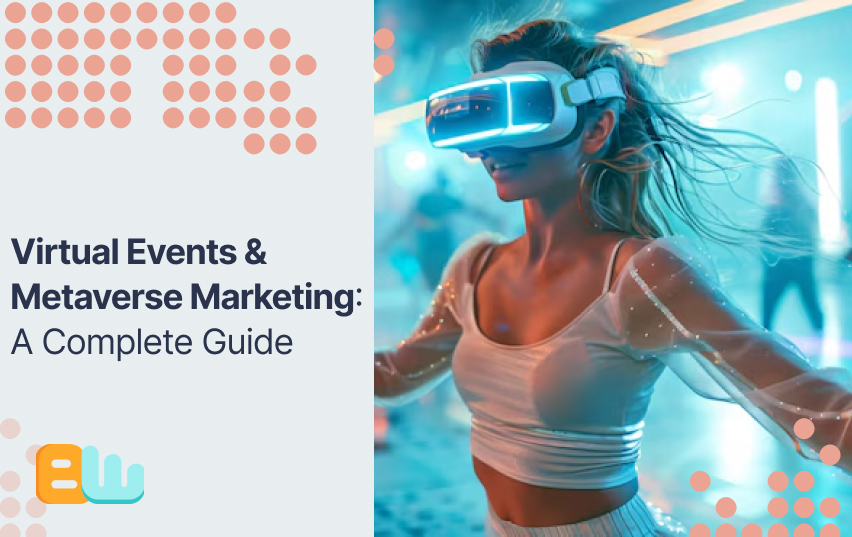
Are you ready to take your digital marketing efforts to the next level? The metaverse is already here and is revolutionizing the way that marketers engage with consumers through virtual worlds.
You’re in the right place in case you’re wondering if virtual events in the metaverse are worth your marketing budget or if they’re just another tech trend. Everything you need to know about organizing a successful metaverse virtual event will be covered in this guide, from preparation to implementation to outcome evaluation.
Introduction to Virtual Events in the Metaverse
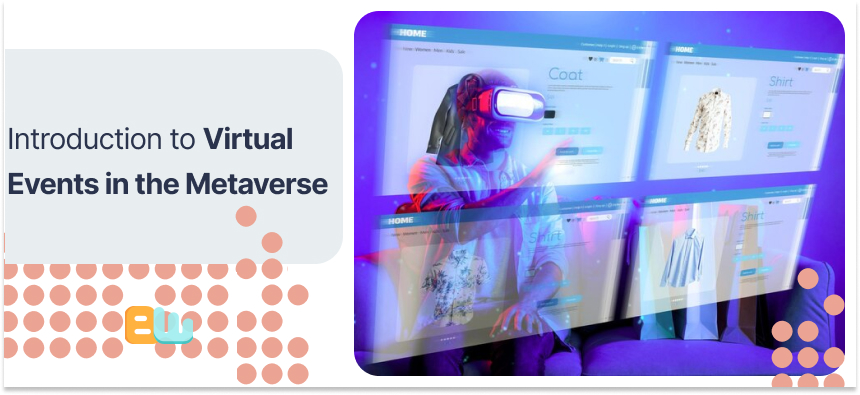
How Virtual Events Have Evolved in Recent Years
Remember when “virtual events” meant a basic webinar with a PowerPoint presentation? Those times have long since passed. Virtual events have changed from basic online get-togethers to complicated digital experiences since the pandemic.
In 2019, virtual events were considered as second-best alternatives to in-person gatherings. By 2023, they’ve become destinations for many participants, with attendance rates surpassing physical events.
From webinars to virtual conferences, from 2D environments to immersive 3D worlds where avatars interact with businesses, network, and perform in ways that were unthinkable before, the evolution has been mind-blowing.
Understanding the Metaverse: Beyond Virtual Reality
Virtual reality headgear and game platforms are only one aspect of the metaverse. Basically, the metaverse is the result of digital and physical worlds transforming into shared, long-lasting settings.
Consider the metaverse as the next step up from the internet, where you may enter and engage with many elements directly rather than watching them on screens. Although there are debates about different platforms such as Decentraland and Meta’s Horizon Worlds, the metaverse ecology is diverse and growing quickly.
The durability, compatibility, and user-generated economy of the metaverse set it apart from earlier digital ecosystems. Real economic value can be created and exchanged, assets can frequently relocate between platforms, and your online presence continues even when you’re not online.
Why Businesses Are Turning to Metaverse Marketing
Companies aren’t entering the metaverse only to seem innovative. Real business benefits that are hard to duplicate in other channels are being recognized by them.
In traditional digital events, the attention economy has risen. Ad blockers are becoming more and more common, and social media feeds are crowded. Instead of passively consuming, viewers can decide to participate in immersive experiences offered by the metaverse.
Data reveals that engagement rates in metaverse environments might be 10-20 times higher than typical digital marketing. Participants show stronger brand identity and a greater emotional connection to situations when they are acting as avatars.
7 Key Benefits of Hosting Virtual Events in Metaverse
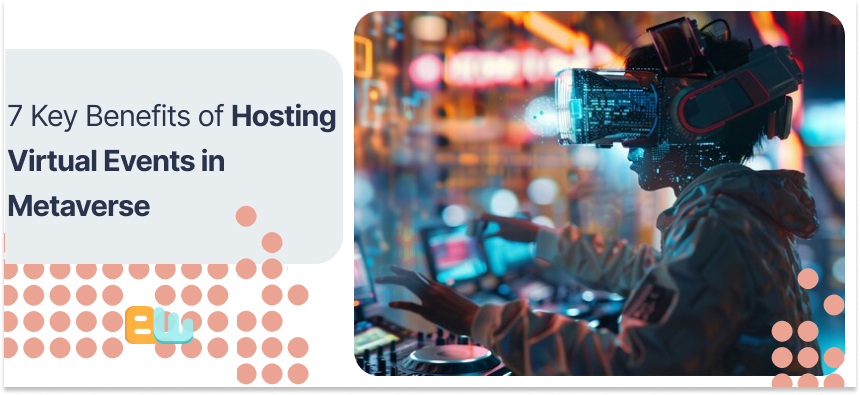
Unlimited Global Reach Without Geographical Constraints
Traditional events are limited because of the needed space and demographical differences. Your metaverse event can welcome people from Tokyo to Toronto without anyone boarding a plane.
Recently, a mid-sized business had a product launch on Decentraland that drew over 5,000 attendees from 43 countries, which would have been too costly and logistically challenging to do as a physical event.
Global accessibility not only boosts attendance but also increases access to your brand experience for audiences who may not otherwise be able to interact with you face-to-face.
Cost-Effective Alternative to Traditional Marketing Events
Let’s discuss numbers: When location, catering, staffing, and logistics are taken into account, a physical conference can easily cost between $500 and $1,000 per attendee. Depending on the platform and experience design, virtual events in the metaverse can lower this to $50 to $200 per participant.
In addition to the immediate financial benefits, metaverse events save participants’ and organizers’ travel costs. Instead of worrying about logistics, your team can concentrate on producing incredible content.
Unlike physical events, virtual assets can be reused and updated for future events, creating long-term value despite the high original cost.
Enhanced Immersive Experiences for Better Engagement
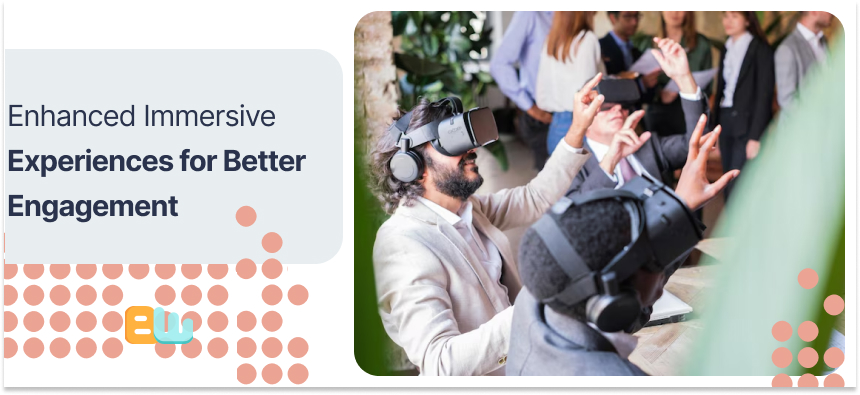
Flat screens and video calls can’t compete with the sense of presence that metaverse environments create. When participants feel physically present through their avatars, their attention and emotional engagement increase significantly.
Companies indicate that information retention via metaverse presentations can be up to 80% higher than from regular webinars, where multitasking and distraction usually happen.
Participants can practically pick up, try on, or test virtual copies of your products in ways that bridge the gap between digital discovery and physical purchase thanks to the interactive nature of metaverse settings, which makes experiential marketing impossible elsewhere.
Valuable Data Collection for Marketing Optimization
It is possible to monitor and examine every activity, conversation, and engagement in the metaverse, offering up-to-date insight about your audience behavior.
These data points are not only accessible but also actionable, such as tracking data that indicates what drew people’s attention, heat maps displaying where guests spent time, and even revealing which events caused the most interaction.
Beyond standard analytics, this comprehensive behavioral data lets you know not only what content did well but also why and how consumers interacted with your brand virtually.
Building Stronger Brand Communities Through Virtual Interaction
Community interactions that are hard to develop through other digital channels can be created by the social aspect of metaverse events. Real connections are made when avatars get together, talk, and exchange stories.
Brands sponsoring regular meetups in metaverse environments claim higher consumer loyalty, increased word-of-mouth marketing and more community participation compared to traditional social media initiatives.
These community connections extend beyond particular events, enabling continuous brand reputation and sponsorship opportunities that lead to producing value long after the first investment.
Sustainability Benefits of Reducing Physical Event Footprints
The environmental impact of large corporate events is substantial—from air travel to printed materials to food waste. Metaverse events dramatically reduce this carbon footprint.
By relocating their annual developer conference to the metaverse, one tech company estimated that they avoided about 1,800 metric tons of CO2 emissions, which is the same as removing nearly 400 cars from the road for a year.
Metaverse events serve as more than just a marketing strategy for companies with sustainability goals; they are a real-life example of environmental principles in action.
Creating Evergreen Content From Metaverse Experiences
Unlike physical events that end when attendees leave, metaverse experiences can be recorded, repurposed, and revisited. Your virtual product showcase can continue generating leads long after the live event concludes.
Smart brands design their metaverse events with content capture in mind, creating assets that feed content calendars for months afterward—from highlight reels to immersive recordings that new customers can experience on-demand.
This evergreen quality transforms your event investment from a one-time marketing expense to an ongoing content asset with compounding returns.
Top Metaverse Platforms for Marketing Virtual Events
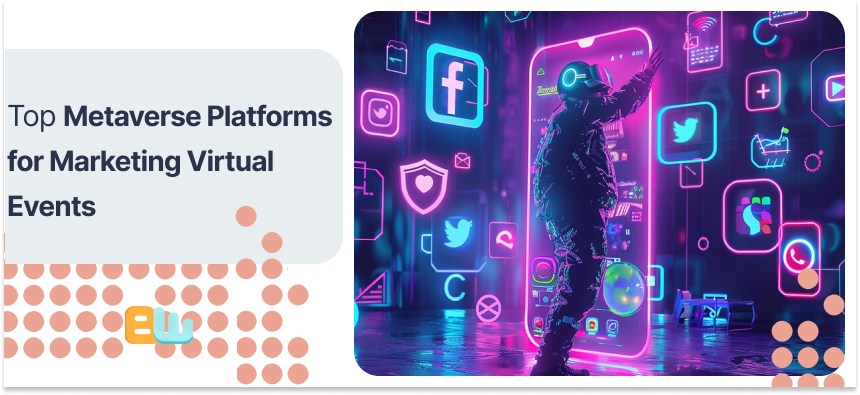
Exploring Facebook’s Meta for Brand Experiences
One of the easiest ways to get started with metaverse marketing is through Meta’s Horizon Worlds, especially for companies that have already made investments in the Meta ecosystem.
The platform’s user base, which could reach billions of Facebook users, along with its advanced creation tools are its main advantages. Meta offers the advantage of familiarity and fewer technical obstacles compared to other platforms for marketers targeting broad consumer audiences through metaverse tactics.
How Decentraland Transforms Virtual Event Marketing
One of the most well-known decentralized metaverse platforms is Decentraland, which gives brands creative freedom and actual digital land ownership.
Well-known companies, such as Adidas and Samsung, have set up permanent locations in Decentraland, enabling both one-time events and continuous brand experiences within their virtual spaces.
Microsoft Mesh: Enterprise Solutions for Virtual Events
Microsoft Mesh provides a metaverse entry point for business-to-business marketers that resonates with current enterprise technologies.
The platform is perfect for high-value customer engagements, training sessions, and product demos since it performs very well in professional settings where presentation quality and data security are crucial.
Microsoft’s approach focuses less on consumer gaming aesthetics and more on accurate representations and actual business applications, which can be useful for firms worried about keeping their professional brand reputation.
Comparing Smaller Metaverse Platforms for Niche Audiences
Even if the main platforms make updates, particular marketing goals are frequently better served by specialized metaverse environments.
Compared to mainstream solutions, platforms such as Somnium Space and Cryptovoxels provide distinctive aesthetic elements and community demographics that may better suit particular company identities.
Spatial has gained popularity for art-focused events because of its gallery-like presentation quality, while RTFKT (now a part of Nike) offers highly customizable avatar experiences centered on digital fashion for fashion and luxury companies.
Which Metaverse Platform Best Suits Your Brand?
Selecting the best platform is about matching your unique marketing goals and audience traits, not about copying rivals or trying to reach the most users.
Consider factors beyond raw numbers: Does your target audience already have a presence on the platform? Does the platform’s aesthetic align with your brand identity? Are the elements used for creation advanced enough for your idea?
The most effective metaverse marketing tactics usually involve being present on several platforms; each of them should be aligned to a certain target audience or step of the customer journey.
How to Plan Your First Metaverse Marketing Event

Setting Clear Objectives for Virtual Event Success
Before creating any virtual experience, set clear goals that are related to business objectives. Are you increasing direct sales, brand recognition, or lead generation?
Knowing your top metrics—such as attendance, engagement time, lead quality, conversion rates, or media coverage—is the first step towards organizing a successful metaverse event.
Resist the temptation to create metaverse experiences simply because they’re novel. Every element should serve your core marketing objectives and provide clear value to participants.
Creating Engaging Content for Metaverse Environments
Content that works in traditional formats won’t automatically translate to metaverse environments. The medium demands rethinking presentation and interaction models.
Break complex information into digestible, interactive segments. Replace passive slide presentations with spatial demonstrations where participants can literally walk through information or processes.
The most engaging metaverse content balances structured programming with opportunities for self-directed exploration, acknowledging that different participants will want different levels of guidance.
Building 3D Assets That Represent Your Brand
Your virtual environments and objects are more than just backgrounds—they’re physical expressions of your brand identity that participants will interact with directly.
Invest in professional 3D design that maintains brand consistency while taking advantage of the medium’s unique capabilities. Poor execution here can undermine even the best conceptual strategy.
Create asset libraries with modularity in mind, allowing elements to be repurposed across different events or platforms to maximize your investment and maintain consistent brand representation.
Promoting Your Metaverse Event Across Digital Channels
Even the most innovative metaverse experience needs proper promotion across traditional channels to drive attendance. Develop a cross-platform strategy that educates potential attendees.
Clear onboarding instructions are essential—many potential participants will be experiencing metaverse environments for the first time and need guidance on technical requirements and access procedures.
Leverage your existing digital communities as launching points, and consider partnerships with established metaverse communities or influencers who can help bridge audiences into these new spaces.
Technical Considerations for Seamless User Experience
Technical friction remains the biggest barrier to metaverse adoption. Prioritize low-threshold entry points and clear user pathways to maximize participation.
Test your experience across different devices and connection speeds to ensure accessibility. Consider offering both full-immersion options (via VR) and more accessible 2D interfaces for broader reach.
Provide dedicated technical support channels during your event—nothing kills engagement faster than participants struggling with access issues while your event proceeds without them.
Measuring Success in Metaverse Marketing Events
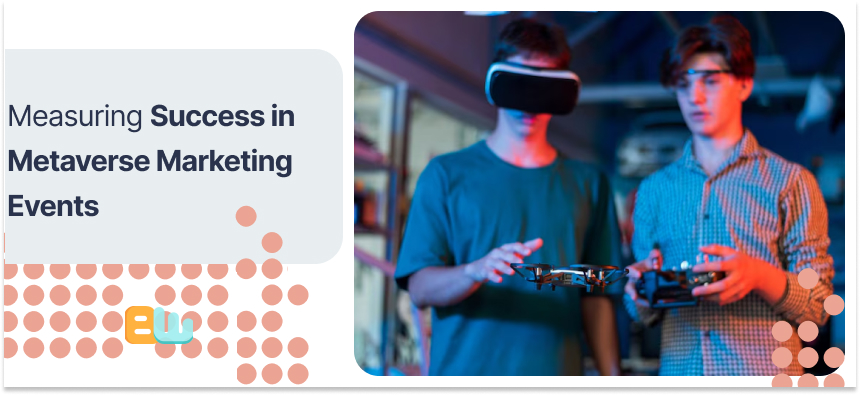
Key Performance Indicators for Virtual Events
Effective measurement starts with the right metrics. Beyond basic attendance figures, track engagement quality through metrics like average participation time, interactive touchpoint completion, and social sharing.
Set benchmarks by comparing your metaverse event performance against both traditional digital events (webinars, social campaigns) and in-person events to understand relative effectiveness.
Develop scoring systems that weight different types of engagement based on their correlation to business outcomes, allowing for more sophisticated ROI analysis beyond raw participation numbers.
Tools for Tracking Engagement in the Metaverse
Although third-party tools usually offer more extensive data collection and analysis skills, major metaverse platforms offer native analytics.
Similar to retail analytics in physical events, think about placing virtual signs around your area to monitor movement patterns and consider time at particular displays or events.
By visualizing the locations of participants’ time spent in your virtual environment, heat mapping technology can highlight the content elements that were most and least noticed.
Analyzing User Behavior in Virtual Environments
Metaverse analytics reveal patterns impossible to track in physical events. Analyze not just what content was consumed, but how participants physically interacted with it in three-dimensional space.
Look for correlation between specific interaction patterns and downstream conversion behaviors. Did participants who examined your virtual product from all angles convert at higher rates than those who viewed it passively?
Use these behavioral insights to refine both future metaverse experiences and your broader marketing strategy, applying spatial engagement lessons across channels.
Converting Metaverse Interactions into Real-World Revenue
The ultimate measure of metaverse marketing success is its impact on business outcomes. Implement clear conversion pathways from virtual experiences to real-world actions.
Exclusive offers, personalized follow-ups based on interaction data, and seamless handoffs between virtual and physical shopping experiences all help bridge the reality gap.
Track attribution carefully to understand which elements of your metaverse experience most effectively drive revenue, allowing you to double down on high-performing components in future activations.
ROI Calculation Models for Metaverse Marketing
Calculating true ROI for metaverse marketing requires accounting for both immediate returns and long-term asset value that traditional marketing ROI models might miss.
Factor in the reusability of digital assets, the extended lifespan of evergreen virtual experiences, and the compound value of community building when assessing total return.
Companies finding the greatest success with metaverse marketing are developing custom ROI frameworks that capture both tangible metrics like lead generation and intangible benefits like brand perception shifts and relationship building.
5 Innovative Metaverse Marketing Case Studies

How Nike Created Nikeland in Roblox
Since its establishment in 2021, Nike’s Nikeland in Roblox has had over 7 million visitors, making it one of the most successful brand integrations in the metaverse.
With games and personalization possibilities that perfectly resonated with Roblox’s platform culture and Nike’s brand identity, the experience masterfully creates a balance between brand visibility and true user value.
Most impressive is Nike’s approach to commerce: rather than focusing on direct sales, Nikeland builds brand affinity through experience, with research showing participants subsequently demonstrate 27% higher purchase intent for physical Nike products.
Virtual Concerts Transforming the Music Industry
Warner Music Group’s partnership with The Sandbox demonstrates how entertainment brands can extend artist experiences beyond physical limitations through metaverse events.
In addition to creating new revenue streams through limited virtual elements, its virtual concert series, which included musicians like Deadmau5, reached audiences that were fifteen times greater than those that could be participated in real locations.
Attendees stayed an average of 73 minutes at the concerts, indicating engagement levels similar to those at live events but with significantly cheaper production costs, proving that these are more than just new experiences, according to the statistics.
Fashion Shows in the Metaverse: New Retail Frontier
Balenciaga’s groundbreaking fashion experiences across Fortnite and their own virtual environments have redefined luxury marketing for digital natives.
Their approach connects virtual fashion directly to physical products, creating a flywheel effect where digital exposure drives physical sales, which in turn enhances the prestige of their digital offerings.
The results speak for themselves: 60% of participants in their virtual fashion experiences were new to the brand, with the initiative driving a 41% increase in Gen Z engagement with Balenciaga’s physical retail channels.
B2B Product Launches in Virtual Environments
Cisco transformed their traditional product launch approach by creating a persistent virtual campus in Microsoft Mesh where enterprise clients could explore network infrastructure solutions in three dimensions.
The virtual environment allowed for demonstrations impossible in physical settings—literally making the invisible visible by showing data flows through networked systems in an interactive spatial context.
Compared to their previous digital launch formats, the metaverse approach generated 3.5 times more qualified leads and dramatically higher information retention among participants, as measured by post-event technical assessments.
Future Trends in Virtual Events & Metaverse Marketing
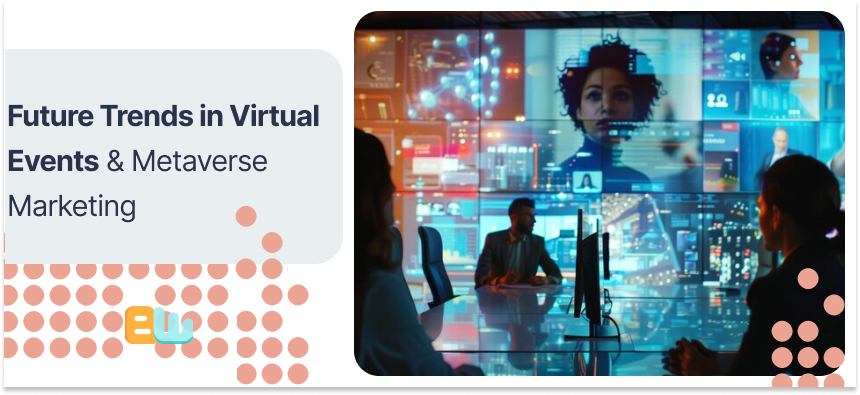
How AI Will Transform Metaverse Marketing Experiences
With intelligent virtual people acting as guides, representatives, and engagement tools, artificial intelligence (AI) is quickly moving from a backend technology to a central component of metaverse experiences.
AI-powered real-time environment adaptation will be a feature of the future generation of metaverse marketing, enabling the creation of customized experiences without human participation.
A fundamental change from scheduled events to constant engagement will be made possible by these technologies, which will allow “always-on” brand presences that create meaningful interactions with visitors despite time zone or staffing limitations.
The Rise of Virtual Influencers in Brand Promotion
Virtual influencers such as Lil Miquela and Noonoouri are becoming marketing titans in brand promotion.
Because they may appear in many locations at the same time and exist naturally in virtual worlds, these digital personalities provide special benefits for metaverse marketing that human influencers do not.
Forward-thinking brands are developing their own proprietary virtual personalities that serve as long-term brand assets rather than contracted partnerships, owning both the relationship and the audience completely.
NFTs and Digital Ownership in Marketing Events
Non-fungible tokens are developing into advanced marketing tools that connect virtual experiences with real value and exclusivity, going beyond simple tools.
NFTs are being used by companies like Adidas and Pepsi to create engagement models based on digital ownership, in addition to being used as digital collectibles and access cards to unique metaverse experiences.
Instead of using NFTs as products or sources of income, the most creative strategy is to use them to reward advocacy and participation, establishing token-gated communities that encourage continued involvement.
Preparing for Web3 and Decentralized Virtual Experiences
The metaverse’s long-term approach indicates that users will have more control over their digital identities, assets, and experiences across platforms as it becomes more decentralized.
Innovative marketers are already experimenting with decentralized autonomous organizations (DAOs), which rethink the relationship between a brand and its customers by granting them direct control over brand experiences and development.
For brands that are prepared to accept collaborative partnerships with their communities, these strategies offer huge advantages, but they also require major organizational adaptation.
Common Challenges and How to Overcome Them
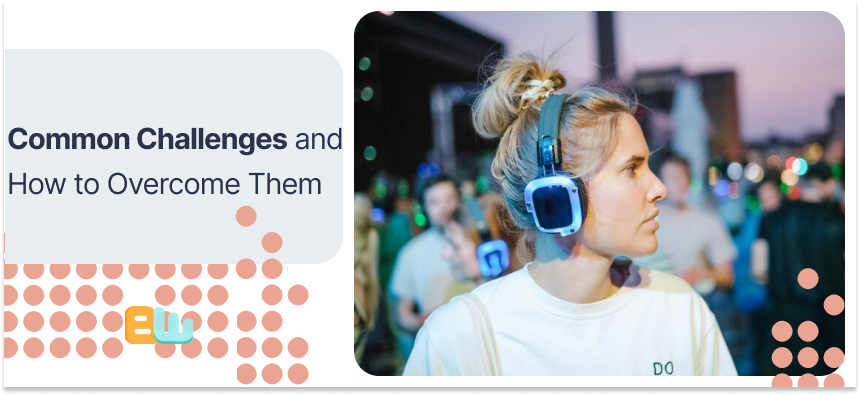
Addressing Technical Barriers to Entry for Audiences
The single largest barrier to the adoption of the metaverse is still technical friction.
Provide a variety of access choices, from simple browser-based interfaces to complete VR immersion, to guarantee that no one is left behind because of technological know-how or hardware limitations.
Think about developing “onboarding concierge” services that offer white-glove technical support to guarantee smooth participation regardless of technical skill.
Balancing Innovation with Accessibility in Design
The temptation to showcase cutting-edge capabilities often conflicts with the need for intuitive user experiences. Finding the ideal combination between originality and usability is key to successful metaverse marketing.
In virtual environments, apply well-established UX principles: feature disclosure and clear approaches to avoid overwhelming new users.
Before launching, test your experiences with different user groups, taking note of how different generations differ in their expectations for spatial navigation and level of familiarity with new interfaces.
Protecting Brand Safety in Open Metaverse Environments
Open metaverse platforms present unique brand safety challenges compared to controlled marketing channels. Develop comprehensive moderation strategies before launching any public activation.
Consider creating semi-private branded spaces that offer the community benefits of open platforms while maintaining appropriate content controls and behavioral standards.
To ensure that your team can address bad behavior without ruining the entire experience for other participants, establish clear reaction guidelines for any potential interruptions.
Managing Budget Expectations for Metaverse Marketing
The cost structure for metaverse marketing differs significantly from traditional digital channels, often requiring substantial upfront investment before demonstrating returns.
Build your business case around total cost of ownership rather than single-event metrics, accounting for the reusability of assets and the long-term value of persistent virtual environments.
Start with focused pilot projects that test key concepts before committing to large-scale implementations, allowing for data-driven budget allocation based on demonstrated performance.
Training Your Team for Virtual Event Management
Few marketing teams currently possess all the skills needed for successful metaverse execution. Invest in training existing staff while strategically supplementing with specialized expertise.
Develop cross-functional teams that bridge traditional marketing capabilities with gaming, 3D design, and virtual production skills—either through upskilling or strategic partnerships.
Create detailed knowledge management systems that capture learnings from each activation, building organizational competency over time rather than remaining dependent on external partners.
Conclusion: Is Metaverse Marketing Right for You?
Evaluating If Your Brand Is Ready for Metaverse
Not all brands must enter the metaverse right now. Evaluate your preparedness in light of organizational capabilities, strategic goals, and audience alignment.
Products that benefit from spatial display, customers that are already active in virtual or gaming environments, and brand positioning that prioritizes innovation are the best markers of metaverse marketing success.
Starting Small: Testing the Metaverse Waters
The most successful metaverse marketing programs start with focused experiments rather than massive launches. Begin with limited experiences that test key hypotheses about audience engagement.
Consider partnering with established metaverse events or communities before building your own environments, allowing you to learn platform dynamics and audience expectations with lower investment.
Building a Long-Term Virtual Events Strategy
Approach metaverse marketing as a long-term capability development rather than a one-off campaign tactic. Build roadmaps that span multiple activations with increasing sophistication.
Connect your metaverse strategy to broader digital transformation initiatives within your organization, positioning these capabilities as fundamental future marketing infrastructure rather than experimental projects.
Partnering with Metaverse Marketing Experts
Even with internal capability building, strategic partnerships remain essential for most organizations entering metaverse marketing. Identify partners who complement your team’s strengths.
Look beyond technical execution capabilities to find partners with deep understanding of virtual community building and experience design—the human elements that ultimately determine success.
Since the metaverse marketing ecosystem is developing quickly, collaborative innovation and constant knowledge exchange are more valuable than strict vendor contracts.
